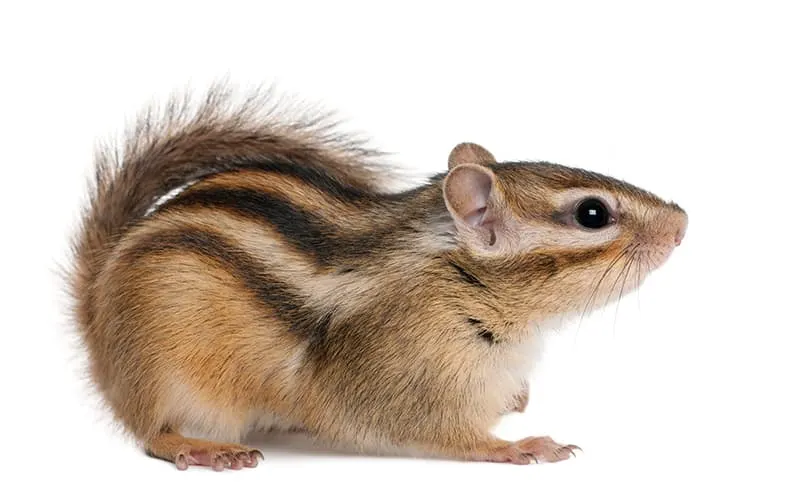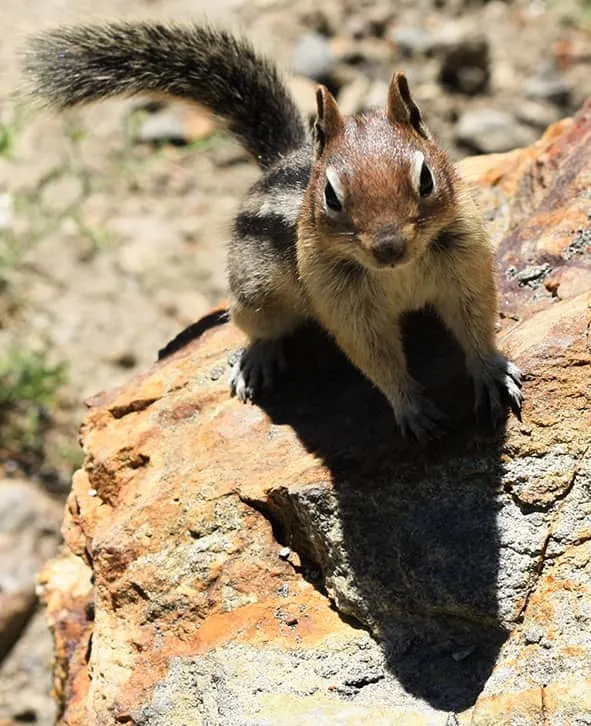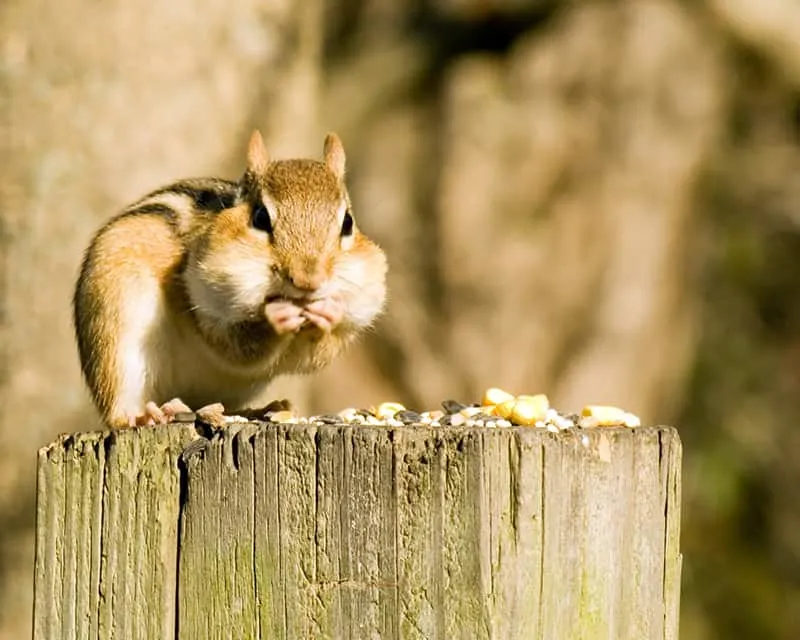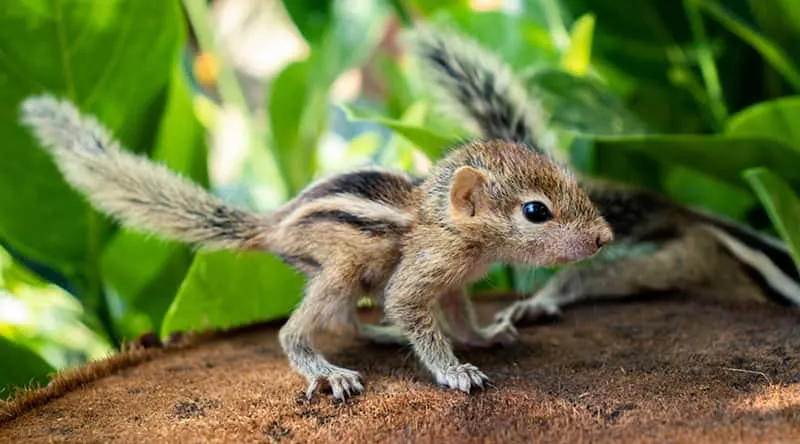Are you fascinated by chipmunks? Many kids have seen the chipmunk cartoons with Alvin and the Chipmunks or Chip and Dale. Learn lots of chipmunk facts here. Read about the chipmunk’s habitat, burrow, diet, and more.

Physical Description
Chipmunks are little furry mammals and the smallest members of the squirrel family. Chipmunks have adorable eyes, short erect ears, striped backs, bushy tails, and round cheeks.
A chipmunk typically weighs less than a pound and weighs between 1 and 5 ounces. They measure 7 to 8.5 inches in length, including their tail. The tail of a chipmunk accounts for around half of its total length.
Chipmunk fur and stripes can be a variety of colors depending on the species. Certain chipmunks are brown with black, white, and reddish-brown stripes running from head to tail. Other chipmunks have fur that varies in color from brown to yellow to gray with black and white stripes.
Chipmunk stripes also vary in terms of number and location. Some chipmunks have two sets of stripes on their backs. Many chipmunks have stripes on their faces and backs. Some chipmunk stripes extend all the way down to the top of the front legs.

Geographical Location
Chipmunks are classified into 25 different species. All but one chipmunk species lives in North America. The Siberian chipmunk lives outside North America. The eastern chipmunk is found primarily in the eastern United States and Canada. Western chipmunks are found in the western United States and western Canada.
All chipmunks are native to North America except for the Siberian chipmunk. The Siberian chipmunk is native to Northern Asia. The pet trade brought the Siberian Chipmunk from Asia to Europe in the 1960s. This chipmunk can now be found in most of northern Asia and Europe.
Chipmunk Facts about their Habitat
Chipmunks like to live in wooded areas, but they can be found in a wide range of habitats. Plains, deserts, meadows, urban parks, and neighborhoods are all habitats that chipmunks live in.
Chipmunks will nest in logs and bushes but prefer to dig underground burrows to use as a home. Chipmunks keep within a third of a mile of their burrow because if a predator approaches, they can quickly escape.
A chipmunk burrow is a series of tunnels dug by a chipmunk. Chipmunks have two types of burrows. The shallow burrows are where chipmunks go to hide during the day when they are out foraging. The deeper burrow system is more elaborate. The deeper burrow includes connecting tunnels and chambers.
There are different chambers for food, sleeping, and waste. Chipmunks line the chambers with plant debris and keep the chambers incredibly clean.

Habits
Chipmunks are solitary, territorial, and defend their burrows. Chipmunks communicate using chirps and body language. Chipmunks use chirps to warn other chipmunks to stay away from their territory. People frequently mistake chipmunk chirps for bird sounds when they hear them.
Chipmunks are most active in the spring, summer, and fall. Many chipmunks hibernate during the winter, depending on how cold it gets where they live. Chipmunks hibernate in a state known as “torpor.” Their heart rate and body temperature fall while they sleep. Chipmunks awaken every few days throughout the cold winter season to eat and poop.
Diet
On of the interesting chipmunk facts is that they are omnivores and are not picky eaters. A chipmunk's diet contains anything from berries, seeds, and grass to frogs and earthworms. Chipmunks will climb trees to gather nuts and bird eggs, and they will even consume newly fledged birds.

During the warm months, chipmunks gather extra food and store it to use during the cold months. It only takes a chipmunk two days to collect enough food for the entire winter. Chipmunks are called hoarders because they collect and store more food than they need.
Offspring
Chipmunks mate twice a year with different partners, once in the spring and once in the summer. Females may use a mating call to attract male chipmunks.
Twice a year, mother chipmunks give birth to 4-5 babies. The mother chipmunk gives birth to her chipmunk pups after about a month of pregnancy. When chipmunk pups are born, they resemble pink jellybeans and weigh less than 3 grams.

A chipmunk mother watcher over her young and chirps to warn them of danger. After six weeks the juveniles emerge from the burrow to explore. By the age of eight weeks, juvenile chipmunks are ready to leave the burrow and live alone.
Classification and taxonomy
Kingdom: Animalia
Phylum: Chordata
Subphylum: Vertebrae
Class: Mammalia
Order: Rodentia
Family: Sciuridae
Genus: Chipmunks
Chipmunk Facts: Their History
Chipmunks diverged from mice and rats approximately 70 million years ago. Scientists believe the chipmunk's stripes are caused by a particular gene that produces a light color. Scientists believe the light color evolved into stripes over time.
Predators
Any living species that is larger than a chipmunk is a potential chipmunk predator. Creatures ranging from large birds like owls to smaller mammals like foxes, would enjoy one chipmunk as a snack. Humans are chipmunk predators because we need to keep chipmunks from ruining yards and structures.
Humans may move into chipmunk areas and ruin the natural habitat. Palmer's chipmunk is endangered because of habitat loss. Palmer’s Chipmunk only lives in an area in the Nevada Mountains. All other chipmunk populations are thriving.
Lifespan
North American chipmunks only live for around 2-3 years in the wild. Siberian chipmunks can live for up to 10 years in the wild. Captive chipmunks can live up to 10 years.
What Does a Chipmunk Sound Like?
Click on this audio file to hear what a chipmunk sounds like.
25+ Fascinating Chipmunk Facts
- A chipmunk can gather up to 165 acorns in a day.
- Chipmunks have cheek pouches that they use to store food while foraging.
- The camouflaged entrance to a chipmunk burrow can be as long as 20 feet.
- A group of chipmunks is called a “scurry.”
- Chipmunks in captivity sleep 15 hours a day.
- Chipmunk burrows can be anywhere from 10 to 30 feet long.
- Baby chipmunks can be called pups, kits, or kittens.
- Male chipmunks are called “bucks.” Female chipmunks are called “does.”
- Siberian chipmunks are one of the smaller species of chipmunks.
- Baby chipmunks are born blind and hairless.
- Chipmunk burrows have several hidden entrances.
- A squirrel and a chipmunk can be told apart because a chipmunk always has stripes.
- It is hard to tell a ground squirrel from a chipmunk. The ground squirrel doesn't have back stripes.
- Chipmunks are diurnal. They are only active during the day.
- The Least Chipmunk is the smallest species of chipmunk.
- Chipmunks aren't aggressive, but if cornered, they will bite and scratch.
- Chipmunks make good pets if they have a big enough cage.
- People use garlic or peppermint oil to keep chipmunks away from their yards.
- Male chipmunks' vocal sacs inflate when they chirp.
- Female chipmunks are bigger than male chipmunks.
- Chipmunks are great for the ecosystem!
- The chipmunk's stripes serve as camouflage.
- A Japanese nickname for the Siberian chipmunk is “Slippers of the Gods.”
- People should not feed chipmunks, even when they beg for food.
- Chipmunk burrows can reach depths of up to 3 feet underground.
- A chipmunk's heartbeat drops from 350 beats per minute to 4 beats per minute during hibernation.
- Chipmunks are also known as Striped Squirrels, Chippers, Munks, and Timber Tigers.
- A Native American legend tells the story of how the chipmunk got its stripes.
- A chipmunk can run up to 21 miles per hour.
- Chipmunks are rodents that are part of the squirrel family.
- Chipmunks spend more time on the ground than in trees.
- The Eastern Chipmunk is the largest chipmunk species.
- Chipmunks have 3 different types of calls. The chip, a deeper call, and the startle call
- Even though chipmunks are cute, they can carry diseases such as rabies and plague.
- Chipmunks trim their teeth down by gnawing on wood.
- Chipmunks are very good at climbing birdfeeders to steal birdseed.
- Some bird species have learned not to nest in chipmunk habitats. The birds don't want their young eaten by chipmunks.
- Chipmunks have excellent vision and sensitive whiskers.
- We often see chipmunks because chipmunks are bold and busy creatures!
We hope you liked learning all about chipmunks. Let us know if you have any interesting chipmunk facts to share. We’d love to hear them.
You don't want to miss learning about these cool mammals.
